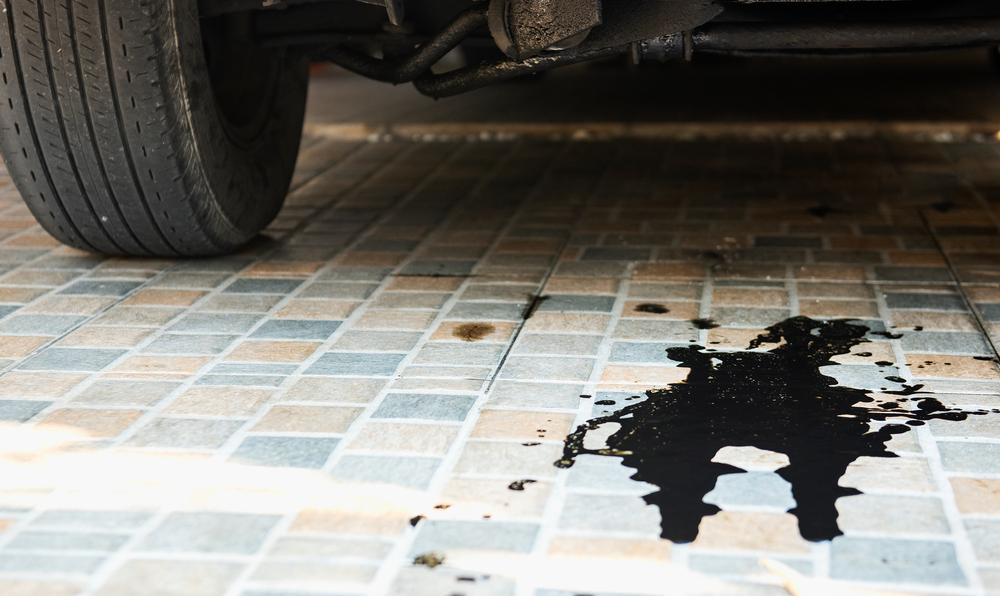
I’m writing this from the first NAB Show in three years. And I can tell you most radio people I’ve met and bumped into – new faces and old friends – are jubilant about being here. A real convention with real people – and not on a Zoom screen – is indeed a feel-good moment.
And radio people are eager to get right back to it. The session that Paul and I moderated has generated some buzz, and I wanted to share with you some of the reasons why that’s happening. The panel was called: “A GPS Session For Your Station’s Car Radio Strategy.” Our goal was to set the tone – where is the radio industry positioned vis a vis the car – its #1 listening location. What are the current auto tech trends and how will they affect radio? And what can broadcasters do to optimize the in-car listening experience for advertisers, listeners, and the car manufacturers (and dealerships) themselves?
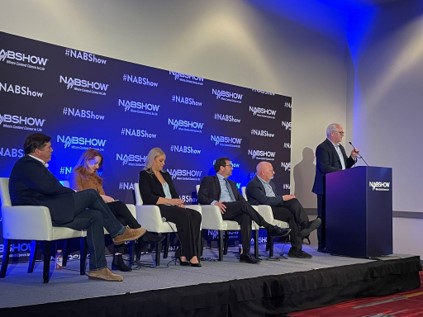
It was a tall order for a one-hour session. But Paul and I had a lot of help from Lesley Rohrbaugh from CTA/CES, Joe D’Angelo from Xperi, and Steve Newberry and Suzy Schultz from Quu Interactive (all pictured).
After Paul set the scene, I showed some slides from our newly released Techsurvey 2022 – data I’d been saving for this session. And it was far from pretty. Remember our surveys are heavily comprised by core radio listeners – members of station email databases by and large. When their radio listening habits become shaky or even unstable, we’d better pay attention.
While AM/FM radio is the top source our respondents go to when on four wheels, our trending indicates the overall degree of consumption is heading lower. Like an oil leak, the drip-drip-drip of lower in-car listening shows up on the data tables. This year, 56% of in-car consumption is made up of listening to broadcast radio stations. But it has been steadily going down over the past several years.
In the session, I commented that in the car, the radio industry is “leaking oil” – slowly but surely losing share in an automotive environment where it’s surround by big, well-heeled brands and platforms that are competing hard to increase their usage in cars. This is a growing problem for radio, and one that Mr. Goodwrench can’t fix.
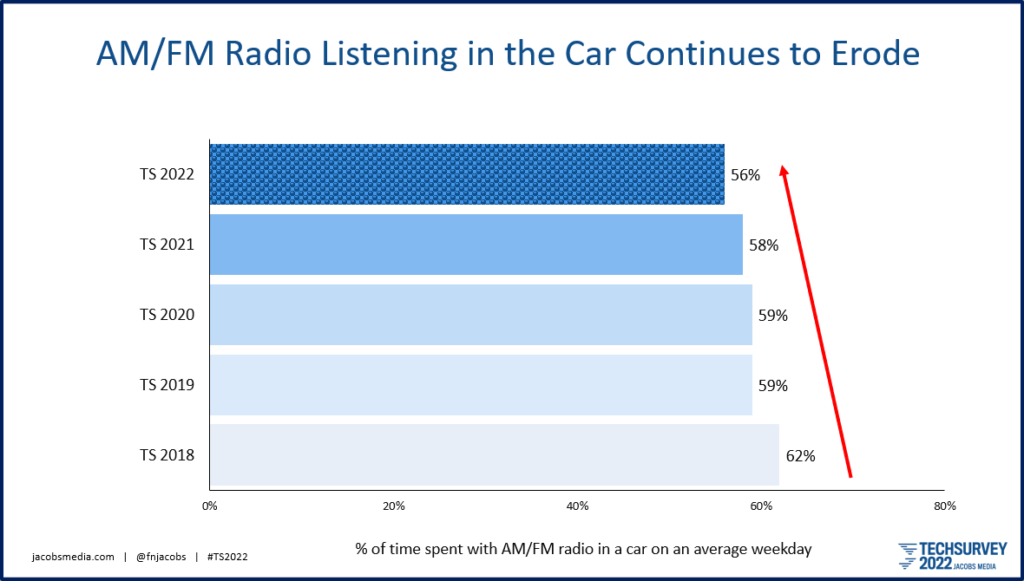
No, the bottom isn’t dropping out. But there’s no question radio’s dominance in the car is showing pressure cracks coming from other media that have become more available and accessible in dashboards.
More and more consumers now own fully connected cars, with in-dash entertainment systems like Ford Sync or Chrysler UConnect. In fact, three in ten now own a vehicle with this equipment, the all-time high for Techsurvey. And when we look at the in-car listening habits of people who drive these cars, we see radio weakening while other audio sources – satellite radio, streaming platforms, and podcasts gaining strength.
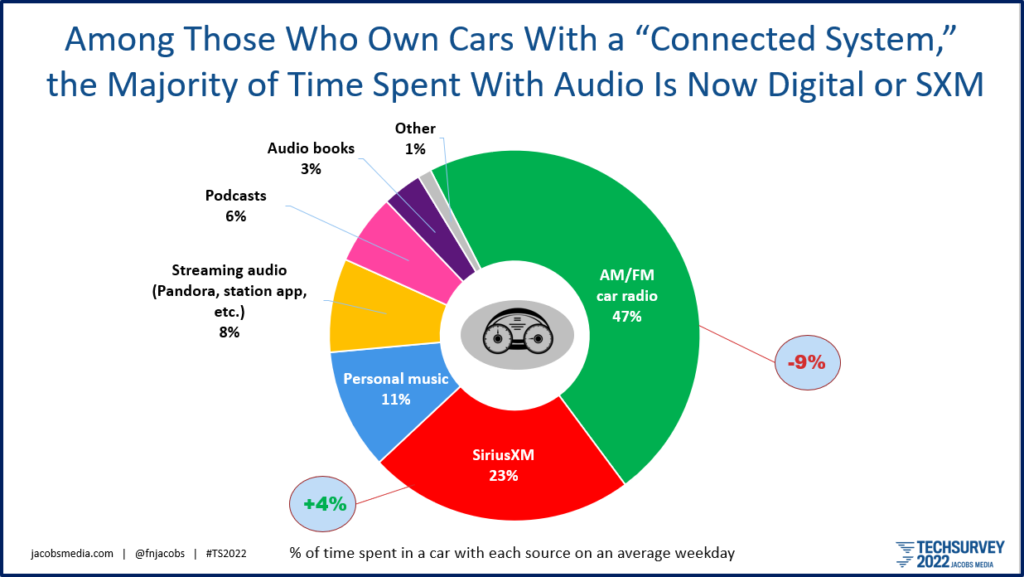
The circled percentage changes tell the story. Among connected car owners, AM/FM consumption drops a precipitous 9 percentage points; SiriusXM takes a 4 point jump, probably because most of these vehicles offer free subscriptions for months to new car buyers.
But I believe there’s something else going on here. When you buy a vehicle with the equivalent of an iPad in the center of the dash, everything looks better. That is, if your content providers are programming and managing their metadata well. The artist and title information, channel logos and album artwork, and visuals in general all look great on these displays.
And there’s the displays that accompany the music, talk and commercials on AM/FM radio station. To be fair, the in-dash experience differs by market and their broadcasters. But it is very checkered. Some stations look great, are managing their metadata well, and look competitive with a Spotify playlist or listening to Lithium on SiriusXM.
But other stations are frankly substandard, either out of neglect, ambivalence, or ownership actively ignoring set guidelines that would help the way their stations look in the car. Information in all caps, incorrect artist/title info or album art, and commercials scrolling on top of other commercials – or worse, programming content.
In 2017, we conducted an audit for the NAB to assess the quality of American commercial radio’s look in the dash. We saw numerous signs that many station had no dashboard strategy. It was not a rarity to see displays like the one pictured below:
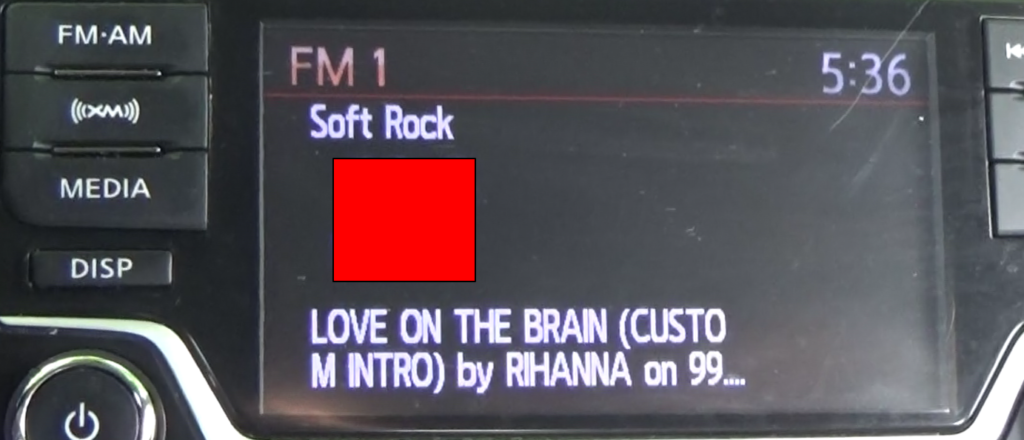
How metadata is utilized by radio broadcasters can provide the industry with a level playing field up against the likes of satellite radio and digital streaming platforms. Or it can be a deal-breaker – an erosive practice that communicates a station is ambivalent about creating a desirable in-car experience.
To provide more information for radio broadcasters, Techsurvey 2022 also addressed the issue of desired metadata. What do drivers want to see on their dashboard screens?
We learned, for example, that nearly three in four respondents drive cars with the ability to display artist and title information.
And so we asked those same people to provide us with feedback on desired features, using a list of possible metadata inclusions.
Below is a list of the top eight most important dashboard features a radio station might provide, above and beyond the table stakes info: artist and title.
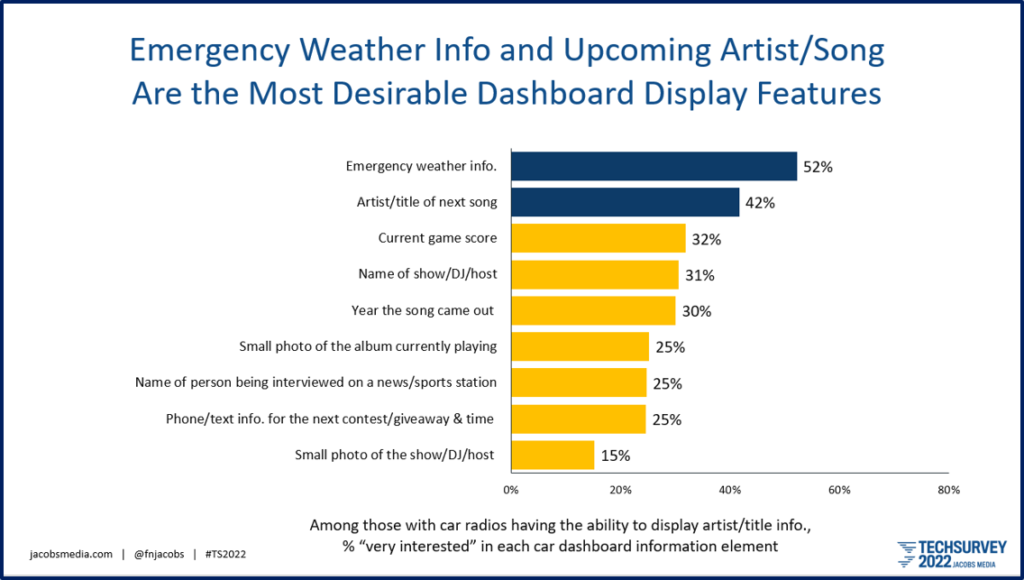
A majority vote for emergency weather information, while more than four in ten like the idea of seeing the artist and title of the next song the station is going to play. And three in ten would love to see the current score of a game the station is carrying, the name of the DJ, host, or show, as well as the year of release of the song currently playing.
Stations may not want to undertake all these metadata features, but the data definitely point to some highly desired bits of on-screen info. Techsurvey stakeholder stations, of course, can access this information for their discreet audience which is obviously better than seeing it for the entire sample.
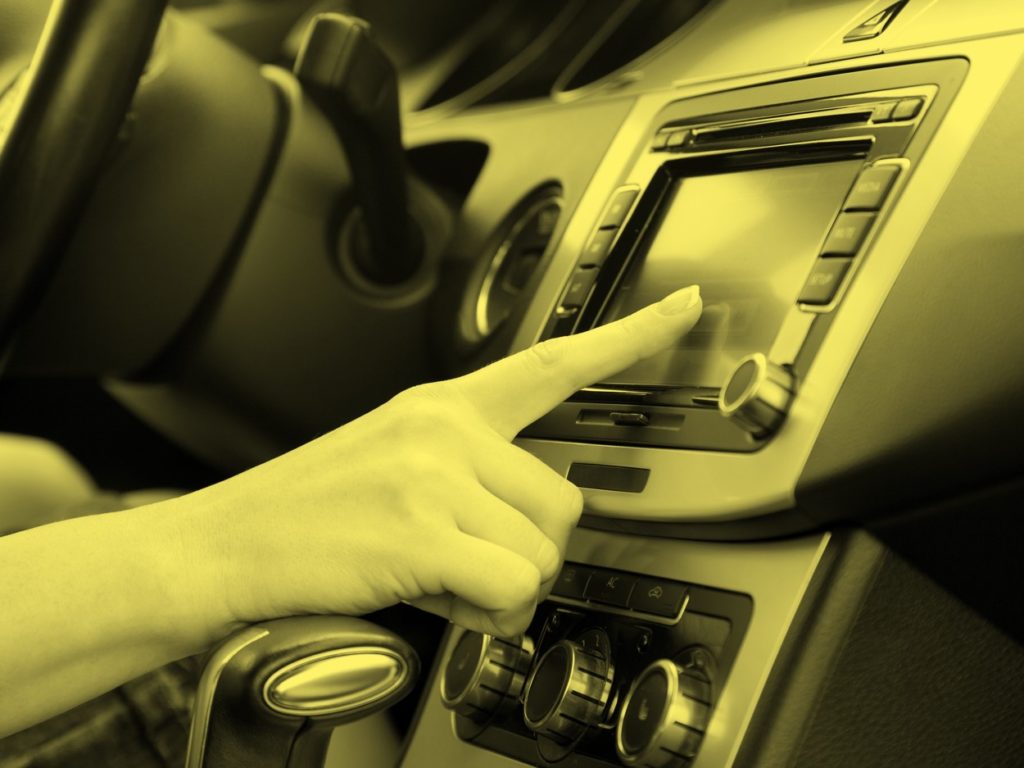 It’s also an indication that metadata in cars can help radio create better experiences in many driving situations: commuting to and from work, as well as going to school, shopping, running errands, and schlepping the kids around.
It’s also an indication that metadata in cars can help radio create better experiences in many driving situations: commuting to and from work, as well as going to school, shopping, running errands, and schlepping the kids around.
Smart PDs and marketers will seize these findings and more actively program their dashboard metadata to coincide with listener tastes and desires. This is another platform in the digital arsenal – a chance to improve the way radio looks in its top listening location.
We will continue to conduct the research, track the data you see above, as well as develop new question areas to explore and discover. Your job is to put the data to use.
As we’re learning, expanding video screens in cars can be a difference-maker for radio, helping it keep pace with other audio content specialists.
And who knows? If we do it right, we just might stop that annoying leak.
- Media And Technology In 2025: Believe It Or Not! - April 18, 2025
- In Radio, You Just Never Know - April 17, 2025
- The Secret To Making A Great Podcast (And Great Radio) - April 16, 2025




Thanks, Fred, for telling us what we need to know, and also what we can do.
I have a Ford SYNC in my car, but it’s an older model, so I don’t have images, but I’ve made sure to have what metadata I can see correct; artist and title on songs, and metadata with the titles of our newscasts and even high school sports. I can see that I need to up my game some, though, and I appreciate the info. Now I just have to figure out how.
Be happy to provide more guidance and info, Don. Thanks for the comment, and for caring enough to get it right. Don.
Thanks for such an important read, Fred.
It is desperately obvious that radio has to step up it’s dash game. I feel that this is another one of those things that programmers are not trying hard enough to dominate. That picture you posted above, in my market, it’s the story. What kills me is the amount of times we’ve been told to clean up our “cart” information that plays on the dash, and the complete disregard of the teams to actually do it.
I feel this goes along with the texture of your station and overall perception. Is your info sloppy and in all caps with abbreviations? (We have a station here like that. It’s gross.)Then why should they care if you don’t? When they find themselves on the competitor, and they don’t have a solid answer as to why, I’ll bet it’s one of those little things that gives a listener anxiety in the car.
Have a great day!
Spot-on, Ms. Toren. I hate to dump more work on PDs, especially these days. But this stuff is table stakes. If you want to compete, you need to look as good as they do.
I don’t know if its true even many years later, but the “next” song/artist feature was suggested to our IT team several times, at several stations and I was told “we can’t do that because it’s not legal”. With digital delivery systems in abundance, it would seem a simple set of code could make this possible. I don’t even know if RCS, Enco, Wide Orbit or Audiovault gives you the chance to provide that. But yeah, Fred- the dashboard experience is still lacking on many stations, kinda like station’s websites which really don’t do much to tell me what the station is all about -but I DO get all of my Pete Davidson/Kim Kardashian info there.
It would seem like a small technical hurdle to overcome, Dave. We saw great reactions to the feature in our one-on-one groups for Quu, and reinforced in Techsurvey.
Great findings, but not surprising.
Let’s address the elephant in the room. A great dash strategy won’t help radios’ weak content, marginal air talent, crushing spot loads, dated slogans, and rear-view mirror programming.
Create great radio and listeners will seek you out.
Of that there is no doubt, Beau. Even on a touch screen, garbage in – garbage out.
Thank God someone had the courage to say this. I believe there have been few fresh programming concepts introduced in years (as opposed to a derivative ideas). In the meantime, podcasting and others reinvent themselves continuously. The problem isn’t with the medium, its with the message.
“But other stations are frankly substandard, either out of neglect, ambivalence, or ownership actively ignoring set guidelines that would help the way their stations look in the car. Information in all caps, incorrect artist/title info or album art, and commercials scrolling on top of other commercials – or worse, programming content.”
Appreciate that, Steve. Thanks for the comment.